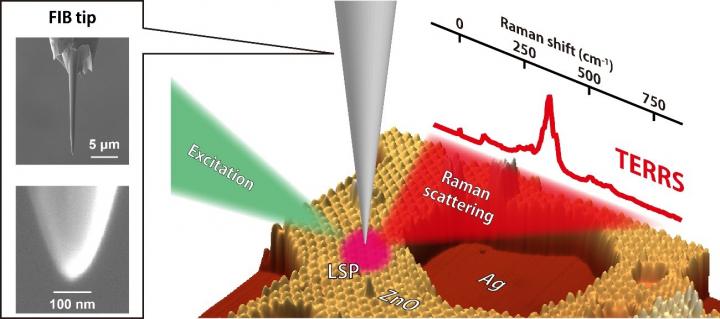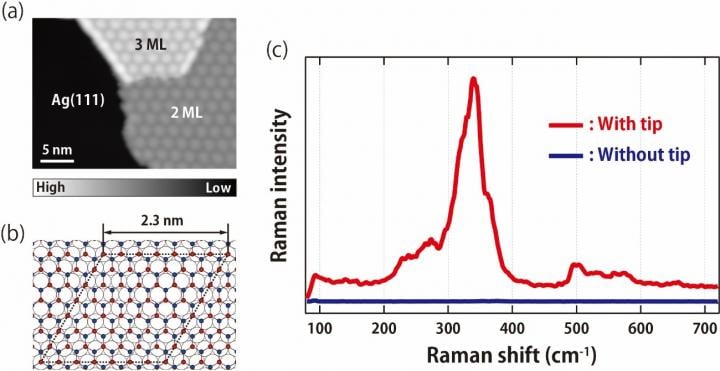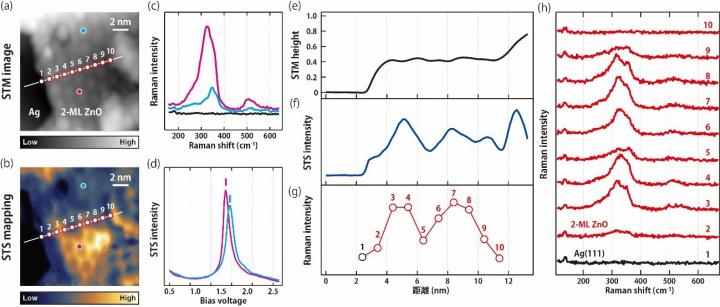
Tip-Enhanced Raman Spectroscopy Provides 1-nm Resolution
BERLIN, Sept. 6, 2019 — Tip-enhanced resonance Raman spectroscopy (TERRS) has been demonstrated by a research team at Fritz-Haber Institute. The results suggest that TERRS could offer a new approach for the atomic-scale optical characterization of local electronic states.
The researchers demonstrated TERRS on ultrathin zinc oxide layers epitaxially grown on a Ag(111) surface in which both physical and chemical enhancement mechanisms were operative. The underlying process was examined by modifying the localized surface plasmon resonance in a scanning tunneling microscope junction and recording different-thickness zinc oxide films that exhibited a slightly different electronic structure.

Tip-enhanced resonance Raman scattering is measured by a silver tip fabricated by focused ion beam milling. Localized surface plasmon is excited by an excitation laser, which generates enhanced Raman scattering from ultrathin zinc oxide films grown on a single-crystal silver surface. Courtesy of Takashi Kumagai.
In combination with scanning tunneling spectroscopy (STS), the research team demonstrated that the TERRS intensity was dependent on the local electronic resonance of the zinc oxide/Ag(111) interface. The team also showed that the spatial resolution of TERRS was dependent on the tip-surface distance and could reach nearly 1 nm in the tunneling regime. A comparison of STS and TERRS mapping showed a correlation between resonantly enhanced Raman scattering and the local electronic states at near-atomic resolution.

Tip-enhanced resonance Raman spectrum of ultrathin ZnO films on a Ag(111) surface. (a) STM image of 2- and 3-monolayer ZnO films epitaxially grown on Ag(111) at 78 K. (b) Schematic of the ZnO film. (c) Tip-enhanced resonance Raman spectrum of the ZnO film. Courtesy of Takashi Kumagai.
Resonance Raman spectroscopy is a powerful tool to analyze a specific chemical structure at a high sensitivity, but its spatial resolution has been restricted to a few hundred nm due to the diffraction limit. The Fritz-Haber team, led by Takashi Kumagai, was able to overcome this limitation by exploiting extreme field confinement at a metal tip apex through localized surface plasmon excitation and achieve 1-nm resolution with TERRS.

Correlation between tip-enhanced Raman scattering and the local electronic structure of the ZnO film. (a-b) STM image and STS mapping of the ZnO film. (c) Tip-enhanced Raman spectra recorded at different sites over the ZnO film (red and blue) and the Ag surface (black). (d) Constant-current STS recorded at different sites over the ZnO film. (e-g) Line profile of STM height, STS intensity, and Raman intensity. The line is indicated in (a-b). (h) Tip-enhanced resonance Raman spectra recorded along the line in (a-b). Courtesy of Takashi Kumagai.
Tip-enhanced resonance Raman spectroscopy could be used to investigate specific chemical structures at the nanoscale and at the single-molecule level, and to study local defects in low-dimensional materials and active sites of heterogeneous catalysis.
The research was published in Nano Letters (https://doi.org/10.1021/acs.nanolett.9b02345).
Published: September 2019